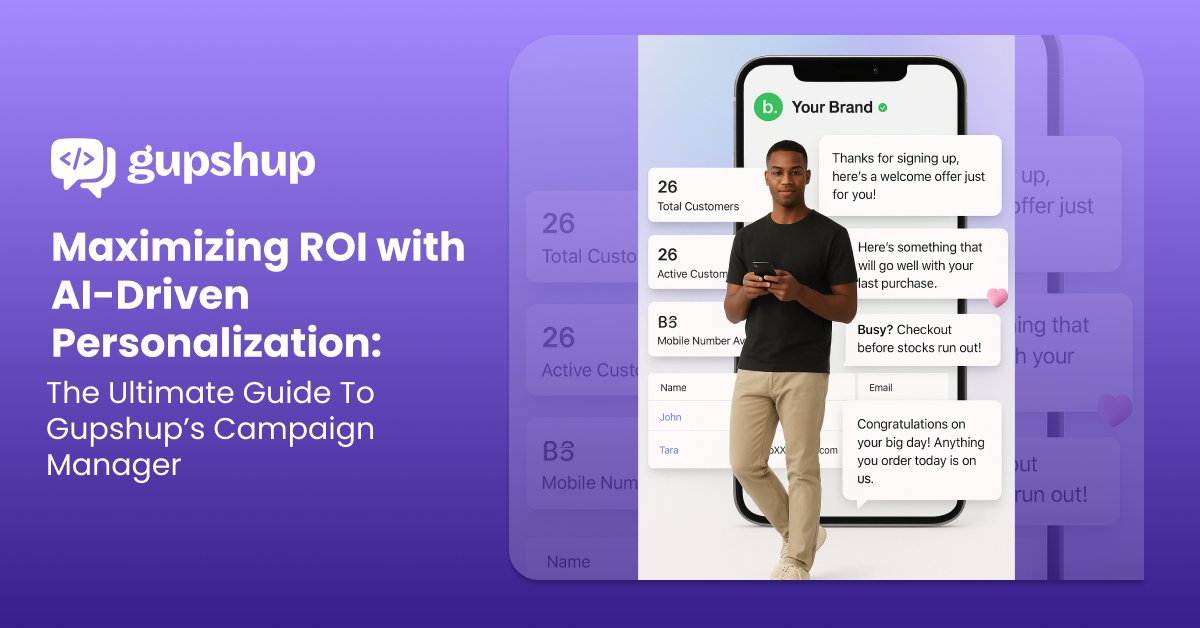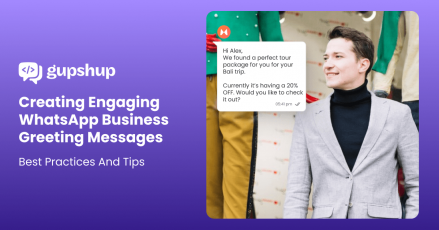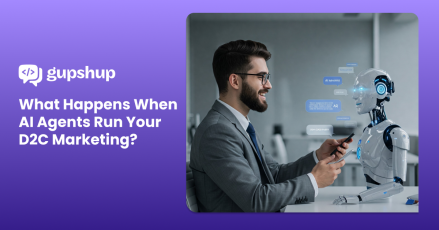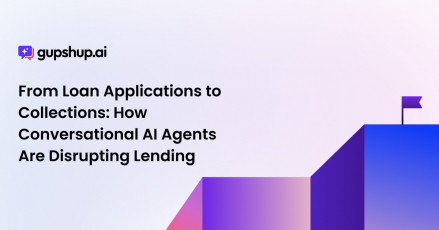Maximizing ROI: A Guide to Personalization with Gupshup’s Campaign Manager

71% of consumers want brands to tailor their interactions and provide personalized campaigns, and 76% get frustrated when that doesn’t happen. Their main requirement is wanting to feel understood.
Which is why old-school marketing is becoming a money drain. Mass email blasts and untargeted ads drive customer acquisition costs (CAC) while engagement plummets. Marketers end up spending more to reach customers who engage less.
This is where AI-driven personalization changes the game. AI agents analyze customer data, provide real-time tracking, and can help businesses send highly relevant messages at the perfect moment and increase customer lifetime value (LTV). Companies that get personalization right generate 40% more revenue than average players. Instead of feeling like mass marketing, these campaigns create meaningful one-on-one interactions at scale.
Gupshup’s Campaign Manager makes this effortless. It enables businesses to engage customers through personalized, two-way conversations, ensuring the right message reaches the right person at the right time.
The result? Lower CAC, higher customer LTV, and marketing that actually delivers ROI.
In this guide, we’ll explore how to use Gupshup’s AI-driven Campaign Manager to move beyond basic chatbots, deliver hyper-personalized marketing, and maximize your ROI.

The first step in upgrading your marketing ROI is moving beyond traditional chatbots to Agentic AI.
Early-generation chatbots were like interactive FAQs; they followed scripted flows and responded to specific keywords. They were useful for handling simple queries but often fell short in engagement and personalization. They tend to be reactive and transactional, providing generic answers and often leading the user down a fixed decision route.
Agentic AI, in contrast, represents the new wave of intelligent customer engagement. AI Agents are powered by advanced machine learning (including large language models) that allow them to –
→ Understand context
→ Maintain memory of past interactions
→ Learn from each conversation
A basic bot might say, “I’m sorry, I didn’t get that,” but an AI Agent can interpret ambiguous requests and adapt its approach on the fly. This evolution opens the door to far more personalized campaigns and meaningful customer interactions.
To illustrate the difference, here’s a comparison between traditional chatbots and modern AI Agents:
| Aspect | Traditional Chatbots | AI Agents |
|---|---|---|
| Interaction Style | Reactive: answer basic queries when asked. | Proactive: can initiate or steer conversations intelligently. |
| Context & Memory | Limited memory; often forgets context between questions. | Remembers context and prior interactions to personalize responses. |
| Capabilities | Handles simple, scripted tasks (FAQs, basic transactions). | Executes complex, multi-step tasks (e.g., plan a trip, complete a purchase) autonomously. |
| Intelligence & Learning | Rule-based relies on static decision trees and predefined flows. Learns very little beyond initial programming. | ML-driven: understands natural language, learns from each interaction, and adapts behavior to achieve goals. |
| Personalization | Basic personalization (e.g., using a name in greeting if provided). | Deep personalization using customer data and preferences to tailor content in real-time. |
| Integration | Siloed; may not connect to external systems or data (limited to the chat interface). | Integrated; can plug into databases, CRM, or APIs to fetch info and perform actions (e.g., check inventory, update an order). |
| Channel Reach | Often text-only on a single channel (e.g., website chat). | Omnichannel presence (web, mobile apps, messaging apps, voice assistants) for a seamless experience. |
AI Agents are a significant leap forward. They can handle ambiguity and multi-channel messaging that would stump a regular bot.
So, how can marketers practically implement these AI-driven, personalized experiences? Gupshup’s Campaign Manager provides an all-in-one solution. It’s a marketer-friendly platform for building, executing, and optimizing conversational campaigns across messaging channels.
Let’s break down some of its standout capabilities that make personalized marketing at scale possible:
1. Personalized multi-channel Campaigns
- Targeted campaign automation:
You can send a message that speaks directly to a customer’s intent. Gupshup’s Campaign Manager segments audiences by behavior, demographics, and purchase history, delivering intent-based messages—like exclusive offers for loyal shoppers or cart reminders—at the right moment. - Interactive & trigger-based campaigns:
Ever browsed a product online, left without buying, and then received a perfectly timed message nudging you to complete your purchase? That’s trigger-based marketing in action. Gupshup allows you to set up event-driven messages, like a WhatsApp notification for an abandoned cart or a follow-up SMS after a website visit. - WhatsApp notification campaigns:
Using personalized, one-time, or recurring WhatsApp messages, you can stay connected with customers. Whether it’s sending order updates, appointment reminders, exclusive deals, or festive offers, Gupshup ensures that your messages land at just the right moment.
2. Simplified campaign creation & management
- Industry-specific customizable templates:
Not sure where to start? Gupshup offers a library of pre-built, industry-specific templates that make campaign creation a breeze. Whether you’re in banking, retail, or travel, you can simply select a template and customize it with rich media, images, videos, buttons, and more (without any coding). - Real-time customer journey adaptation:
Marketing isn’t static, and neither are your customers. Gupshup lets you dynamically adjust messaging flows based on real-time events. If a customer browses without buying, they get a personalized offer. After a purchase, they receive an upsell recommendation or a loyalty reward. - Seamless integrations:
One of the biggest challenges marketers face is connecting their campaigns with existing tools. Gupshup eliminates data silos with pre-built integrations for marketing automation and CRM platforms like MoEngage and CleverTap.
3. Performance optimization & analytics
- Real-time performance dashboards:
It’s not enough to just send messages; you need to track what’s working. Gupshup provides real-time dashboards that let you monitor message opens, clicks, conversions, and revenue at a glance. See which campaigns are driving engagement and fine-tune them on the fly. - Conversion tracking & revenue analysis:
Not all campaigns are equal; some drive awareness, while others directly impact sales. Gupshup gives you full funnel visibility, helping you measure how many conversions each campaign generated and how much revenue it contributed. This data-driven approach ensures you’re not just running campaigns but actually improving ROI. - Proven performance uplift:
Campaign Manager is built for results, and the numbers speak for themselves:
- 1.7x increase in conversions for businesses using AI-driven conversational marketing.
- 2x higher engagement and retention compared to traditional marketing.
- Up to 20x annualized ROI, thanks to optimized campaign execution.
4. Scalability & flexibility
- Cross-channel orchestration:
Customers avoid just one platform; they hop between WhatsApp, SMS, and RCS. Gupshup keeps messaging consistent across channels, allowing seamless conversations from WhatsApp to SMS while tailoring messages to each platform. - Highly scalable campaign execution:
Whether you’re reaching 1,000 customers or 10 million, Campaign Manager is built for scale. Gupshup processes over 10 billion messages monthly, enabling seamless large-scale campaigns for seasonal sales, flash deals, or urgent alerts, ensuring timely delivery even during peak events like Eid or Black Friday. - Opt-out management & compliance:
Customers should always have the choice to opt-out. Gupshup ensures compliance with GDPR, CAN-SPAM, and WhatsApp policies, providing users with easy opt-out options. This protects your brand from spam complaints.
To get the most out of Gupshup’s AI-powered Campaign Manager, keep these best practices in mind:
Embrace omnichannel integration
Meet your customers on the channels they use most, and create a seamless journey across those channels.
For example, your campaign might start by engaging a user via an Instagram ad that leads into a WhatsApp conversation, which later transitions to SMS for follow-up reminders. With Gupshup, you can integrate channels like WhatsApp, SMS, RCS, Facebook Messenger, and more into one cohesive campaign. Ensure that your messaging is consistent and coordinated.
Use interactive messaging features
Static text messages are easy to ignore; interactive messages invite engagement. Gupshup’s templates allow you to incorporate buttons, quick replies, carousels, and rich media in your messages. Take advantage of these!
For instance, instead of a plain text saying “Check out our new arrivals,” use a carousel template showing images of new products with “View Details” buttons. For a promotional offer, include a one-tap button for “Claim Discount” right in the message. These interactive elements create a more app-like, immersive experience within messaging channels.
Automate A/B testing and optimization
Continuous improvement is key to ROI. Rather than guessing which message or offer will perform best, let data guide you. Using Gupshup’s Campaign Manager, you can set up A/B tests by splitting your audience or trying different message variants sequentially.
For example, test two versions of a WhatsApp broadcast, one with a discount-focused text and another highlighting product quality, to see which gets more clicks. Monitor the real-time analytics. Perhaps one variant yields a 5% higher conversion. You can then roll out the
Monitor and refine with real-time analytics
Don’t set and forget your personalized campaigns. Use the live dashboards to monitor how customers are interacting. If you see a drop-off at a certain message or stage in a journey, investigate and refine it.
For example, if many users aren’t clicking the second follow-up message in a series, maybe the content needs tweaking, or the timing is off. Real-time data might show that users are more active in the evenings, so you could reschedule your messages to 7 PM instead of noon for better results.
Different industries have unique opportunities for personalized campaigns. Here are some use cases and strategies in key sectors, showing how Gupshup’s Campaign Manager can be tailored to each:
Retail & e-commerce
In retail, AI Agents can act as personal shopping assistants for every customer. Imagine a fashion retailer’s AI agent greeting a user on WhatsApp with a personalized message. The agent can showcase a carousel of products in the user’s preferred size and past browsing categories. If the user adds an item to the cart but doesn’t check out, the Campaign Manager can automatically send an abandoned cart reminder 30 minutes later, perhaps with a personalized discount or free shipping offer to close the sale.
Banking & Insurance
Financial services might not seem like a conversational domain at first, but they have embraced AI for personalized customer engagement. With Gupshup, a bank can run a lead qualification campaign on, say, Facebook Messenger or WhatsApp.
The AI agent gathers key details, runs a preliminary eligibility check, and routes high-quality leads to human agents or applications. Unqualified leads are nurtured for future opportunities. This automation reduces costs by streamlining customer interactions.
For insurance companies, policy renewal reminders and cross-sell offers via conversational campaigns can be game changers. Instead of a generic email, an AI agent on chat can reach out to a customer whose policy is due next month. The bot can answer FAQs about coverage, update the user’s details, and even process the renewal payment securely, all within the chat.
Food & beverage
For restaurants, cafes, and food delivery services, conversational AI is like adding a super-efficient maître d’ or server to every customer’s pocket. A quick service restaurant (QSR) chain, for instance, can use Gupshup to automate ordering and promotions on messaging apps.
Additionally, personalized promotions in F&B can significantly boost footfall and sales. For example, a coffee shop chain’s campaign might use location data: whenever a loyalty member is near one of their outlets during morning hours, they get a message with a discount.
The result feels delightfully personal as if the brand knew what the customer was craving. Such strategies drive repeat purchases and strengthen brand loyalty in the food and beverage sector.
Travel & hospitality
The travel industry thrives on personalized campaigns. Travel agencies and platforms can deploy AI trip-planning agents that chat with users to build their perfect itinerary. The AI agent can ask for the user’s preferences (beach vs. adventure vs. culture, budget, dates) and then recommend a customized itinerary, all through an interactive chat.
Hospitality businesses (hotels, airlines, tour operators) are also embracing AI campaigns for customer service and upselling. For example, a hotel chain using Gupshup can automate pre-stay engagement. A week before check-in, guests receive a WhatsApp message from an AI concierge offering assistance with special requests, local recommendations, or bookings. The AI Agent handles inquiries or escalates them to staff when needed.
Across all these industries, the common thread is clear:
Conversational AI + personalization = higher engagement and better ROI.
Gupshup’s Campaign Manager offers AI-powered, flexible infrastructure for effortless tailored marketing across retail, finance, food, travel, and more.
Conclusion: The Future of AI-Powered Personalization
Looking ahead, the integration of AI Agents into marketing campaigns is only going to grow. We’ll see smarter AI agents that can handle even more complex customer journeys, anticipate needs with greater accuracy, and seamlessly blend marketing, sales, and support into one continuous experience. The future of customer engagement is an ongoing dialogue, not a series of disjointed messages.
Gupshup’s Campaign Manager stands out as a must-have solution for the future. It combines the necessary channels, AI technology, and user-friendly design to help any business enter the era of hyper-personalized marketing.
Now is the time to invest in personalization if you haven’t already. Ready to maximize your ROI with hyper-personalized campaigns? Don’t get left behind – try Gupshup’s Campaign Manager and see how AI-driven personalization can elevate your marketing to new heights. It’s time to turn customer conversations into conversions.
Take the leap into the future of marketing with Gupshup today.
FAQ’s
1. What are the 4 D’s of personalization?
To effectively implement personalization, businesses must focus on four key elements:
- Data Collection: Gathering comprehensive customer information.
- Decisioning: Using insights to tailor messaging and experiences.
- Designing Engagements: Creating personalized content based on customer behavior.
- Delivery: Distributing tailored messages through the right channels.
2. How can I stop a campaign that is scheduled?
To stop a scheduled campaign, locate it in the campaign dashboard and delete or cancel it before execution.
3. What are the different reasons for the failure of a campaign?
A campaign may fail due to several factors:
- Duplicate contacts: The system automatically removes duplicate phone numbers from the uploaded list.
- Opt-in validation: Messages are only sent to users who have explicitly opted in.
- Missing variable values: If a required field is empty and no fallback value is set, the message won’t be sent. Media failures may occur if links are incorrectly formatted.








